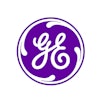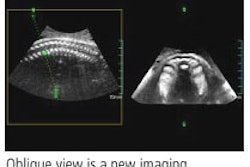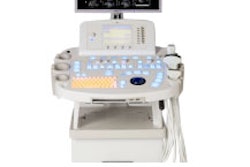CHICAGO - Even the most experienced breast imagers have a tough time picking out smaller lesions on whole-breast ultrasound, according to a study presented Monday at the 2005 RSNA meeting. Successful detection depends on lesion size as well as a reader's skills.
Dr. Wendie Berg, Ph.D., from the American College of Radiology Imaging Network (ACRIN) in Lutherville, MD, and colleagues examined the reliability with which experienced breast imagers were able to detect and interpret lesions on sonography, and shared their results in two RSNA papers.
The readers in this study had passed the qualification tasks for participating in the ACRIN 6666 trial, which is the study of screening breast ultrasound in high-risk women. Berg is the lead investigator for the trial, which got under way in March 2004. As of mid-November, 2,562 out of 2,808 women have been enrolled in ACRIN 6666.
"This entire trial almost didn't get off the ground because of concerns over operator dependence in breast ultrasound," Berg explained. "So these two papers are going to address two different aspects of this issue."
From the ACRIN 6666 enrollees, 10 women with known breast lesions were selected and scanned during one 12-hour session. In addition to being ACRIN-approved, the 11 readers had performed and interpreted 500 breast sonograms in the prior two years. The radiologists had also performed the ultrasound scans and documented lesions based on size, location, features, palpability, and BI-RADS final assessment.
"We considered only lesions that were identified by at least two investigators and used the consensus description as the gold standard," Berg explained. The average scan time for each patient was 31 minutes, ranging from 25 to 42 minutes.
According to the results, 88 unique lesions were identified and the mean lesion diameter was 6.7-mm. Eight lesions were palpable. Of the 968 possible detections, 535 or 55% were made by the readers. As a group, the detection rate ranged from 49% to 66% with 36% of lesions seen by only two to three investigators.
"We looked at what features contributed to lesion detection. Dimension and size were dominant characteristics that played into this with very small lesions, under 3 mm, being very difficult to detect," Berg said.
She offered an example of a 4-mm lesion that was small and deep within the breast. It was seen by 63% of the readers. However, these readers were divided on whether the lesion was a complicated cyst with a BI-RADS 3 or a simple cyst with BI-RADS 2.
Larger lesions were more consistently detected with the readers' detection rate coming in at 97% for lesions 11 mm or larger and 86% for lesions 9.1 mm to 11 mm. The detection rate ranged from 18% to 67.6% for lesions ranging from 3 mm to 9 mm.
The mean size of lesions detected by no fewer than seven investigators was 8.6 mm. The authors found that the likelihood of detection increased by 12% per mm increase from 3 mm to 13 mm.
The group found that "whether the lesion was a cyst or solid mass did not affect detection. We also looked at distance from the nipple … and that did not seem to factor into it. In general, except for one investigator, fatigue did not appear to play a significant role," Berg said.
The group had recently submitted a paper for publication in which the same readers tested their skills in a phantom model and achieved a much higher detection rate of 79%, including smaller lesions, she said.
"We found that consistent detection with lesions less than 11 mm in diameter was problematic with handheld ultrasound even when performed by experienced breast imaging radiologists who have been trained…. Obviously this has potential implications for screening with ultrasound," Berg concluded. "We really require detecting cancers less than or equal to a centimeter in size and that's right about the threshold where we start to see consistent performance."
In a second study, Berg's group evaluated whether these same radiologists could reliably interpret lesion characteristics. The same materials and methods were employed as in the previous study.
"This is obviously a parallel study. The purpose of this analysis was … to examine among these experience breast imaging radiologists performing whole-breast ultrasound the reliability of description of lesion size, lesion location, palpability, BI-RADS features, and BI-RADS final assessment, particularly by lesion."
The images and descriptions were reviewed and lesions were matched across all investigators. Again, only lesions seen by two investigators were included. Intraclass correlation coefficients (ICC) and Kappa statistics were used to measure agreement on lesions features compared to consensus.
Again, 88 unique lesions were identified with a mean size of 7.8 mm. The ICCs came in at more than 0.7 for "clock-face" location, distance from the nipple (using the width of the transducer as a guide), and individual lesion diameter, indicating very high reliability. The Kappa values came in as follows:
Palpability: 0.70 (92% agreement)
Special cases (including cyst, intraductal mass, scar): 0.74
Shape: 0.75.
Echogenicity: 0.49
Margins: 0.67 (94% agreement)
Orientation: 0.75
Posterior features: 0.51
BI-RADS final assessment: 0.56
Finally, clinically significant disagreement between readers was found in only 8.5% of the interpretations. The most extreme disagreement in lesion size was a case of a calcifying fibroadenoma that measured up to 27 mm, but was called at 9 mm by another observer.
Berg's group concluded that amongst trained breast imaging specialists, agreement was good for BI-RADS feature analysis and very good for lesion location and size.
"There was high reliability for lesion diameter and location, which was better than expected," Berg said. "If one considers screening, or even any kind of whole-breast ultrasound, you are obviously going to find incidental lesions that we'd consider 'probably benign.' The fact that the recording of the diameter and location of the lesion was consistent is certainly encouraging. We need that information to allow for follow-up and appropriate management if the lesion should grow."
At the 2004 RSNA meeting, Berg presented the results of a study on ultrasound interpretation skills. In that paper, the authors found that radiologists who scanned patients themselves (versus relying on a technologist) turned in a substantially better interpretive performance. Those who interpreted more ultrasound exams per week also turned in better results.
By Shalmali Pal
AuntMinnie.com staff writer
November 28, 2005
Related Reading
US-guided optical breast imaging separates benign from malignant tumors, October 13, 2005
Breast US readers need more practice with postop changes, December 22, 2004
Breast imagers fare better with hands-on approach to screening ultrasound, December 17, 2004
Copyright © 2005 AuntMinnie.com



















